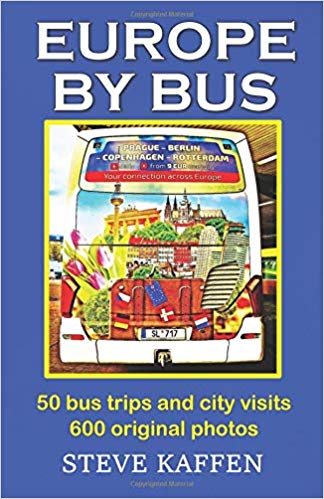2020 Peace Corps Writers Award for Best Travel Book — EUROPE BY BUS by Steve Kaffen (Russia)
 Europe By Bus: 50 Bus Trips and City Visits
Europe By Bus: 50 Bus Trips and City Visits
Steve Kaffen (Russia 1994-96)
371 pages
SK Journeys Publisher
May 2019
$16.00 (paperback)
Reviewed by Craig Storti (Morocco (1970-72)
Europe by bus? Really? Does anyone travel by bus who doesn’t have to? Aren’t buses for commuters? OK, tour buses, for sure. But Steve Kaffen is not talking about tour buses; he’s talking about buses as in the way go to from one city to another—all across Europe, for heaven’s sake! Who would do that when you can take a nice, comfortable train? I was skeptical. Can you tell?
But then I’m an American, and intercity bus travel is not nearly as common in the US; we have cars for that sort of thing. But one of the revelations in Kaffen’s book is how well-developed intercity bus travel is in Europe, within the same country and from one country to another. He lists 11 different providers he used, many of them offering passes for multiple trips or for unlimited trips during a limited period (two weeks, 30 days). There was almost no place he couldn’t get to by bus, one of the advantages over nice, comfortable trains, which connect most major cities but not lesser ones. And Kaffen cites other advantages:
With trains you must arrive at the station early, locate the track, find the wagon and often purchase a seat reservation. Train travel is largely an internal experience, within the train itself, and the views from a rapidly moving train are largely panoramic. The big advantage of trains over buses is time reliability. They ride on separate tracks versus open roads. But to compensate, on the bus you get close-up views of the country’s interior.
And some of the buses are quite nice: double-decker in some cases, many with glass roofs, almost all with wi-fi
But the book is not just or even mainly a paean to bus travel; it’s a guidebook to bus trips, 58 different trips, to be precise, and a quick sketch of what Kaffen does in 47 different cities. And it has 600 original photos. For the most part it doesn’t tell you where to go and what to see, but how to get there on a bus and what the various buses and bus routes are like. If you’re considering taking a bus from Budapest to Munich or Venice to Nice and want to know how to do that, this book is for you. That said, the short descriptions of the 47 city visits are charming and highly idiosyncratic, which keeps them from getting repetitive. You actually look forward to reading about the next city, wondering what the author will find to amuse himself—and you—at his next stop. Here, for a flavor of Kaffen, is part of what he says about Dubrovnik:
I had been out of touch with group tourism. I hit it full steam in the Old Town. Upon entering the main square I heard an American tour leader who could not have sounded more disinterested. “There is the wall, and those are the wall steps to the top, and over there is the church and the ATMs.” And he let his group loose. An independent guide solicited business by placing a kitten in the middle of the square. Tourists came by to play with the kitten. She told the story of the kitten and presented her guiding services.
The great thing about buses is that they permit what is called “slow travel,” which for Peace Corps types is the only way to go. I wrote about slow travel in my book Why Travel Matters; here is an excerpt from what I said in a section called Linger:
All travelling becomes dull in exact proportion to its rapidity. — John Ruskin
The idea will appeal instinctively to the serious traveller: the slower you travel, the more you will see. Indeed, travelling slow could almost be shorthand for much of the other advice in this chapter. “I do think it is this impulse to slow down that all travellers share,” Dan Kieran writes in The Idle Traveller. “The thrill of living in the moment, which is the real destination of all journeys, is what the greatest travel writers are revealing in their meticulous descriptions of the places they go and the people they meet.”
“The American who visits Europe for the first time,” Thomas Knox wrote (in 1881), “is apt to be in a hurry and to endeavor to see too much…. Instances have occurred of tourists who could not tell whether St. Paul’s Cathedral was in London or Rome. Moral: Don’t be in a hurry.”
In the end, travel is not about how many places you see but how much you see of the places you visit.
Buses are moving, of course, not exactly lingering, but they do permit longer views of passing villages and the countryside, a greater accumulation of impressions.
Kaffen’s book fills a genuine void: If you think you might like to take some bus trips on your next visit to Europe, there aren’t that many places you can get this kind of information.
Also by Steve Kaffen:
Asia Without Borders — Crossing the South Asian Expanse, Incredible India and Boundless Bhutan, Australia: Adventures and Encounters, Unexpected Journey, and Minsk and The European Games
•
Reviewer Craig Storti is the author of nine books, including Culture Matters, a cross-cultural workbook used by the U. S. government in over 90 countries. His latest book is Why Travel Matters: A Guide to the Life-changing Effects of Travel. He has also written for a number of newspapers, including The Washington Post, The Los Angeles Times, and the Chicago Tribune. Website: craigstorti.com
No comments yet.
Add your comment